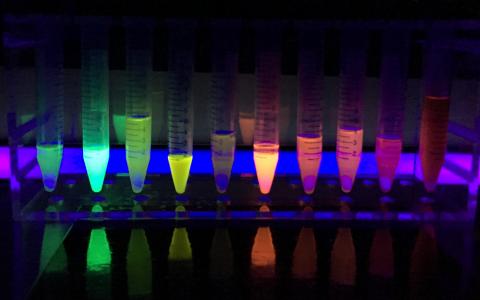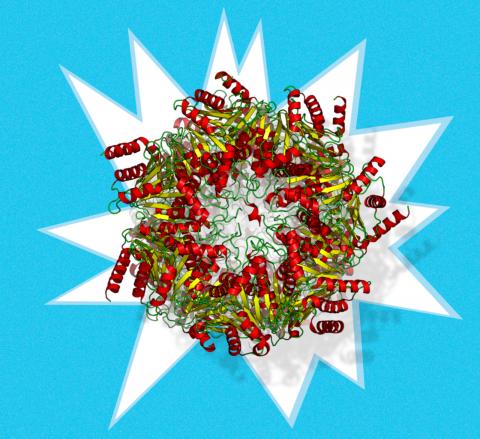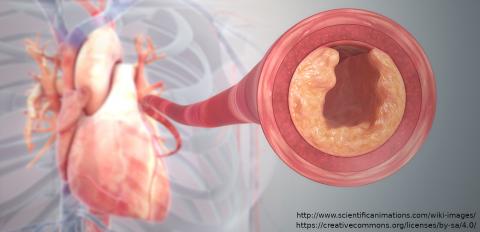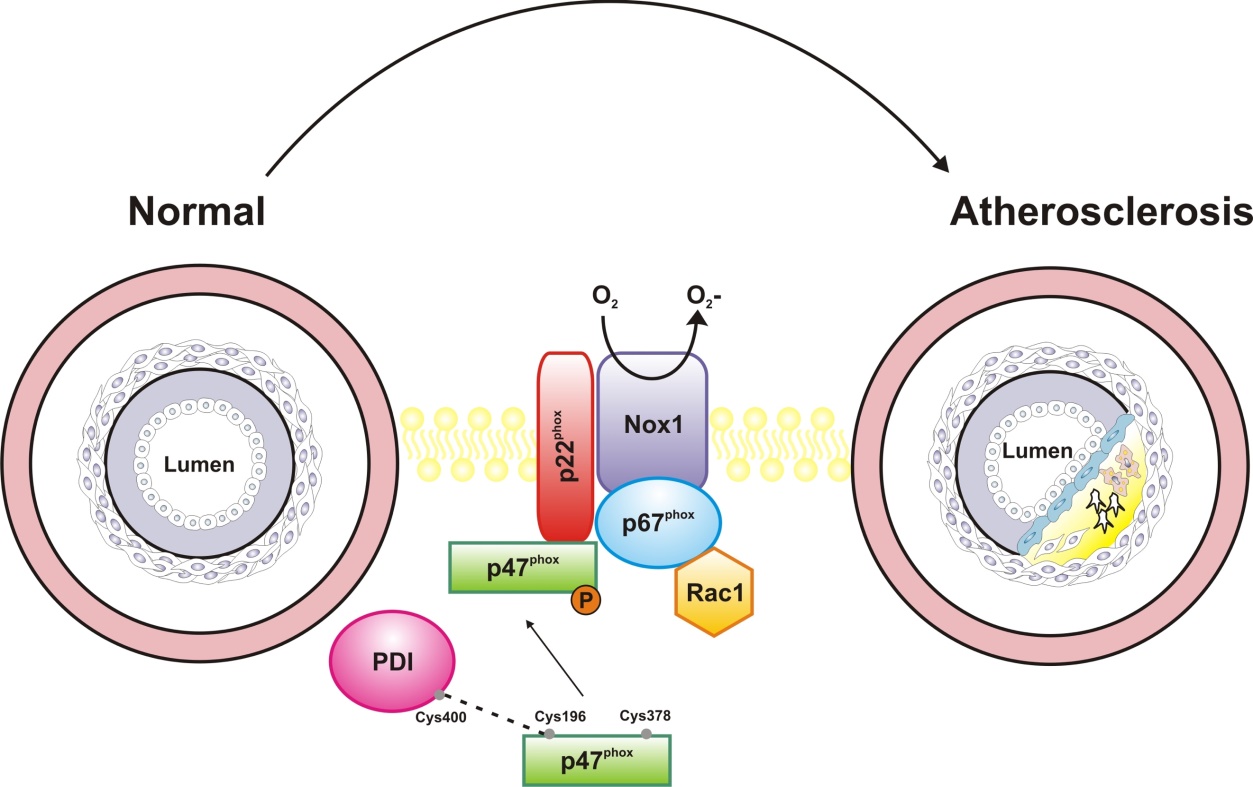Fluorescent protein-based biosensors: potent tools to shed light on redox biochemistry and biology

Main Article by Marcelo A. Comini from Laboratory Redox Biology of Trypanosomes, Institut Pasteur de Montevideo, Montevideo, Uruguay.
Corresponding author e-mail: mcomini@pasteur.edu.uy
Thiol-redox homeostasis from a cellular viewpoint. Major cellular processes (e.g. growth, differentiation, DNA-replication, translation, metabolism, signaling and death) are redox modulated. Among the different types of redox modifications that protein residues can undergo, the reversible oxidation of the cysteine thiol group to disulfide confers this residue the potential to act as versatile molecular switch. In fact, formation or breakage of a (homo or hetero) disulfide bond may have important consequences in protein structure and conformation, and hence on its functional properties (i.e. activity, stability, interaction with partners/ligands, subcellular localization, etc.). In most organisms, thiol-disulfide homeostasis is controlled by two main redox systems: the thioredoxin system and the glutathione/glutaredoxin system; or equivalent systems in certain lineages [1, 2]. Different types of peroxidases are important components of these systems, being able to transfer their oxidation status to target proteins [3].
Location, timing and specificity are key factors for the effective maintenance of intracellular redox balance. Therefore, the redox systems are distributed in different subcellular compartments, with the oxidoreductases and peroxidases providing rapid kinetic control of the cysteine redox state of different protein targets. Worth noting, each organelle/compartment has its own redox profile [4], which implies that the intracellular redox status is not uniform but heterogeneous. This poses an important challenge for studies aimed to address from the simpler to the more complex questions in thiol-dependent redox biochemistry and biology, both at cellular and organism level.
What are the tools available for measuring thiol-disulfide redox state? A set of different chemical probes displaying specificity for thiols is available. Depending on the chemical nature of the probe, the readout of the reaction will be fluorescence, absorption or luminescence. If the protein of interest undergoes a redox-dependent conformational change that translates into a differential migration pattern under denaturing conditions, then the Western blot technique can be used to estimate the proportion of reduced and oxidized target protein. Mass spectrometry-based techniques, combined with selective thiol labeling and enrichment, offer the possibility for large scale, quantitative and high-throughput analysis of the cellular redox proteome [5]. However, taken together, these approaches present several disadvantages that can lead to erroneous conclusions. In several cases, cell integrity is destroyed because the determinations rely on extractive methods (e.g. for some chemical probes, redox Western blot or redox proteomics). This procedure demands the use of specific thiol-blocking agents to “freeze” the redox state of the proteins, in order to avoid non-specific thiol-disulfide exchange between molecules from compartments that are not in redox equilibrium. Although thiol-specific, several chemical probes are unable to distinguish protein- from low molecular weight-thiols or even be directed to specific organelles. In addition, many chemical probes react irreversibly with thiols or even have important collateral redox effects (e.g. oxidation, radical formation, cytotoxicity). In fact, without the appropriate controls (or even with them), the results, commonly referred as “overall redox status”, obtained with these methods are technically biased. Furthermore, the techniques described above provide endpoint measurements or, in other words, “a photo of the movie” that is far from representing the high dynamism that characterize cell physiology. Although multiple sampling may overcome this limitation, the experiments become laborious, prone to variability and expensive.
Can these limitations be overcome? Yes, they can and the key to unlock this door was the development of biosensor technology based on genetically-encoded fluorescent proteins (FP) [6, 7]. FP are engineered into thiol-redox biosensors by introducing a couple of vicinal cysteine residues at the protein surface and in close proximity to residues interacting with the hidden chromophore [8]. The cysteines are the biological recognition element that will “sense” and equilibrate their thiol-disulfide state with that of the surrounding environment. The modification of the redox state of these cysteines is accompanied by small and local conformational changes that modify the protonation state of the chromophore and, hence, its spectral properties [6].
A Danish group headed by Jakob R. Winther pioneered the generation and use of the first thiol-redox yellow fluorescent protein biosensor that proved useful in informing the thiol-redox status of Escherichia coli and yeast [9, 10]. Since then, a manifold of articles reported the generation of new redox sensitive FP variants that not only cover almost the full visible spectra (400-700 nm) but also were fine-tuned to operate in organelles with different redox potentials [5, 6, 7].
Depending on their photophysical properties, the FP-redox biosensors can be classified into intensiometric (single wavelength indicators that exhibit changes in their fluorescence intensity) or ratiometric (dual wavelength indicators that exhibit a shift in either their optimum absorption or emission wavelength intensities). The first are suitable for qualitative measurements because the fluorescence signal will depend not only on the concentration of the target molecule but on the expression level of the biosensor and other factors such as cell thickness and pH. The ratiometric biosensors are preferred for quantitative measurements because the interferences pointed above are cancelled out.
A major achievement in this area have been the development of biosensors coupled to different thiol-disulfide oxidoreductases (glutaredoxin, thioredoxin, mycoredoxin and bacilliredoxin) and peroxidases. Fusion to these redox active enzymes expanded the specificity for different redox species (glutathione, mycothiol, bacillithiol, proteins, and peroxides) and, due to kinetic acceleration, lowered the time scale at which redox events can be measured [e.g. from minutes to (nano)seconds].
Because they are genetically encoded, the biosensors can be expressed transiently (as episome) or stably (inducible or constitutively), the last upon integration of the reporter gene into the genome of the target cell/organism. The generation of stable cell lines allows selecting cell populations with a known and homogeneous expression level of the biosensor. At first glance, the establishment of stable redox-reporter cell lines may appear time consuming. However, it constitutes an unlimited source of material that guarantee more consistent results by bypassing the cytotoxic and epigenetic effects, and the cell-to-cell variability associated to uncontrolled transient expression-based assays.
Fluorimeter (plate reader), fluorescent microscope and flow cytometer are suited instruments to detect signals from FP biosensors. The first may be less sensitive and, hence, require a stronger expression of the reporter gene. Confocal microscopy allows for high spatiotemporal resolution at (sub)cellular level, whereas flow cytometry offers statistical robustness and high-throughput power.
With the exception of Archaea, the redox biosensors were expressed in a wide range of organisms from different Kingdoms and, so far, proved valuable to investigate fundamental questions of redox biology [6].
A bright future. The FP-based redox biosensors feature several advantages summarized in: they are produced by the cell and become functional without further intervention by the researcher and can be targeted to almost any subcellular domain/compartment wherefrom they will inform the thiol-redox state in a non-invasive, real-time and dynamic fashion. As long as there is not spectral overlap, the redox biosensors are compatible with multiparametric analysis relying on the use of complementary fluorescent probes or methods. The possibility of tagging the biosensor to different proteins opens the opportunity to “spy” redox signaling processes that control distinct cellular functions with high molecular and temporal precision. The FP biosensors can be rated as excellent biotools to address major questions in the field of redox biochemistry and biology for many pathophysiological phenomena of interest in transmissible (e.g. infectious) and non-transmissible disease’s models. Last but not least, they also show great potential in the drug discovery area, with applications that encompass the screening of drug libraries (e.g. for the selection or discard of molecules causing redox unbalance) and the study of drug toxicity [11] and mode of action [12].
References
- G. Salinas, M. A. Comini. Alternative Thiol-Based Redox Systems Antioxidants & Redox Signaling, 28(6): 407–9, 2018. | doi: 10.1089/ars.2017.7464
- C. Klomsiri, P. A. Karplus, L. B. Poole. Cysteine-Based Redox Switches in Enzymes Antioxidants & Redox Signaling, 14(6): 1065–77, 2011. | doi: 10.1089/ars.2010.3376
- Y. Go, D. P. Jones. Redox compartmentalization in eukaryotic cells Biochimica et Biophysica Acta (BBA) - General Subjects, 1780(11): 1273–90, 2008. | doi: 10.1016/j.bbagen.2008.01.011
- M. A. Comini. Measurement and meaning of cellular thiol:disufhide redox status Free Radical Research, 50(2): 246–71, 2016. | doi: 10.3109/10715762.2015.1110241
- A. J. Meyer, T. P. Dick. Fluorescent Protein-Based Redox Probes Antioxidants & Redox Signaling, 13(5): 621–50, 2010. | doi: 10.1089/ars.2009.2948
- M. Schwarzländer, T. P. Dick, A. J. Meyer, B. Morgan. Dissecting Redox Biology Using Fluorescent Protein Sensors Antioxidants & Redox Signaling, 24(13): 680–712, 2016. | doi: 10.1089/ars.2015.6266
- C. V. Piattoni, F. Sardi, F. Klein, S. Pantano, M. Bollati-Fogolin, M. Comini. New red-shifted fluorescent biosensor for monitoring intracellular redox changes Free Radical Biology and Medicine, 134: 545–54, 2019. | doi: 10.1016/j.freeradbiomed.2019.01.035
- H. Ostergaard. Shedding light on disulfide bond formation: engineering a redox switch in green fluorescent protein The EMBO Journal, 20(21): 5853–62, 2001. | doi: 10.1093/emboj/20.21.5853
- H. Østergaard, C. Tachibana, J. R. Winther. Monitoring disulfide bond formation in the eukaryotic cytosol The Journal of Cell Biology, 166(3): 337–45, 2004. | doi: 10.1083/jcb.200402120
- R. Wittig, V. Richter, S. Wittig-Blaich, P. Weber, W. S. L. Strauss, T. Bruns, T. P. Dick, H. Schneckenburger. Biosensor-Expressing Spheroid Cultures for Imaging of Drug-Induced Effects in Three Dimensions Journal of Biomolecular Screening, 18(6): 736–43, 2013. | doi: 10.1177/1087057113480525
- J. Franco, F. Sardi, L. Szilágyi, K. E. Kövér, K. Fehér, M. A. Comini. Diglycosyl diselenides alter redox homeostasis and glucose consumption of infective African trypanosomes International Journal for Parasitology: Drugs and Drug Resistance, 7(3): 303–13, 2017. | doi: 10.1016/j.ijpddr.2017.08.001
Marcelo Comini (mcomini@pasteur.edu.uy) holds a degree in Biochemistry (1999) from the Universidad Nacional del Litoral (Santa Fe, Argentina) and a Dr. rerum naturarum (2004) from the Technical University of Braunschweig (Braunschweig, Germany), with a postdoctoral period (2004-2007) at the Biochemistry Centre from the Heidelberg University (Heidelberg, Germany). In 2008, he joined the Institut Pasteur de Montevideo as “Young group leader” of the Laboratory Redox Biology of Trypanosomes and five years later became Principal Investigator. He is a foundational member of the Molecular, Cellular and Animal Technology Program (ProTeMCA) from IP-Montevideo. He was invited to join several European and International consortia devoted to drug discovery research against neglected diseases. He is member of the Sistema Nacional de Investigadores (level 2) and Programa de Desarrollo de las Ciencias Básicas (level 4) from Uruguay. His scientific contributions (59 research articles and 9 book chapters) were published in top peer-reviewed journals and books. The research interest of his team embraces: understanding fundamental aspects of the redox biology of trypanosomatids, the early phase of drug discovery against these pathogens and the development of fluorescent protein-based biosensors.




Add new comment